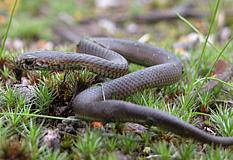Snake
Snakes are cold blooded legless reptiles closely related to lizards, which share the order Squamata. There are also several species of legless lizard which superficially resemble snakes, but are not otherwise related to them. more...
A love of snakes is called ophiophilia, a fear of snakes is called ophidiophobia (or snakephobia). A specialist in snakes is an ophiologist.
An old synonym for snake is serpent; in modern usage this usually refers to a mythic or symbolic snake, and information about such creatures will be found under serpent (symbolism). This article deals with the biology of snakes.
Evolution
The phylogeny of snakes is poorly known due to the fact that snake skeletons are typically small and fragile, making fossilization unlikely. It has however been generally agreed, on the basis of morphology, that snakes descended from lizard-like ancestors. Recent research based on genetics and biochemistry confirms this; snakes form a venom clade with several extant lizard families.
Morphology further suggests that the likeliest ancestors were related to mosasaurs — extinct aquatic reptiles from the Cretaceous — which in turn are thought to have derived from varanid lizards. Under this hypothesis, the fused, transparent eyelids of snakes are thought to have evolved to combat marine conditions (corneal water loss through osmosis), while the external ears were lost through disuse in an aquatic environment, ultimately leading to an animal similar in appearance to sea snakes of today. In the Late Cretaceous, snakes re-colonized the land much as they are today. The best fossil snake remains are from Late Cretateous marine sediments, which supports this hypothesis. Similar skull structure; reduced/absent limbs; and other anatomical features found in both mosasaurs and snakes lead to a positive cladistical correlation, though some features are also shared with varanids. Supposedly similar locomotion for both groups is also used as support for this hypothesis.
An alternative hypothesis is that snakes directly evolved from burrowing lizards, either varanids or some other group. One extant analog of these putative ancestors is the earless monitor Lanthanotus of Borneo, although it also is semi-aquatic. As these ancestors became more subterranean, they lost their limbs and became more streamlined for burrowing. Features such as the transparent, fused eyelids and loss of external ears, according to this hypothesis, evolved to combat subterranean conditions (scratched corneas, dirt in the ears). As with the marine origin hypothesis, snakes re-emerged onto the surface of the land much as they are today. Fragmentary remains that have been found from the Early Cretaceous may refute either hypothesis. Further insight will no doubt also come from more detailed genetic studies.
The great diversity of modern snakes appeared in the Paleocene, probably correlated with the adaptive radiation of mammals following the extinction of the dinosaurs.
Feeding
All snakes are carnivorous, eating small animals including lizards and other snakes, rodents and other small mammals, birds, eggs or insects. Some snakes have a venomous bite which they use to kill their prey before eating it. Other snakes kill their prey by constriction resulting in death by strangulation. Still others swallow their prey whole and alive.
Snakes do not chew their food and have a very flexible lower jaw, the two halves of which are not rigidly attached, and numerous other joints in their skull (see snake skull), allowing them to open their mouths wide enough to swallow their prey whole, even if it is larger in diameter than the snake itself. Contrary to the popular myth, at no point do they "unhinge" their jaws (disarticulate their mandibular joints).
After eating, snakes become torpid while the process of digestion takes place. Digestion is an intensive activity, especially after the consumption of very large prey, and so much metabolic energy is involved that Crotalus durissus, the Mexican rattlesnake, may actually raise its body temperature as much as 6 degrees above the surrounding environment. Because of this, a snake disturbed after having eaten recently will often regurgitate the prey in order to be able to escape the perceived threat. However, when undisturbed, the digestive process is highly efficient, dissolving and absorbing everything but hair and claws, which are excreted along with uric acid waste. Snakes have been known to occasionally die from trying to swallow an animal that is too big.
Snakes do not normally prey on people, but there are instances of small children being eaten by large constrictors in the jungle. While some particularly aggressive species exist, most will not attack humans unless startled or injured, preferring instead to avoid contact. In fact, most snakes are non-venomous or have venom that is not harmful to humans.
Skin
The skin is covered in scales. Most snakes use specialized belly scales to move, gripping surfaces. The body scales may be smooth, keeled, or granular. Their eyelids are transparent "spectacle" scales which remain permanently closed. They shed their skin periodically. Unlike other reptiles, this is done in one piece, like pulling off a sock. It is thought that the primary purpose of this is to remove external parasites. This periodic renewal has led to the snake being a symbol of healing and medicine, as pictured in the Rod of Asclepius. In "advanced" (Caenophidian) snakes, the broad belly scales and rows of dorsal scales correspond to the vertebrae, allowing scientists to count the vertebrae without dissection. If there is not enough humidity in the air while snakes are shedding their skin, it can be very dangerous for the snake, because the dry skin does not shed. Skin that remains attached to the snake can harbour diseases and parasites. A tail tip that is not removed can constrict as the snake grows, cutting off the blood supply to the end of the tail causing it to drop off. A retained spectacle can cause the snake to become blind in the affected eye.
Perception
While snake vision is unremarkable (generally being best in arboreal species and worst in burrowing species), it is able to detect movement. Some snakes, like the Asian vine snake, have binocular vision. In most snakes, the lens moves back and forth within the eyeball to focus. In addition to their eyes, some snakes (pit vipers, pythons, and some boas) have infrared sensitive receptors in deep grooves between the nostril and eye which allow them to "see" the radiated heat. As snakes have no external ears, hearing is restricted to the sensing of vibrations, but this sense is extremely well developed. A snake smells by using its forked tongue to collect airborne particles then passing them to the Jacobson's organ in the mouth for examination. The fork in the tongue gives the snake a sort of directional sense of smell.
Read more at Wikipedia.org




